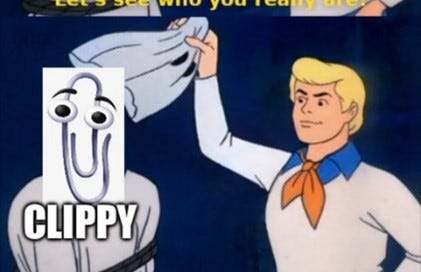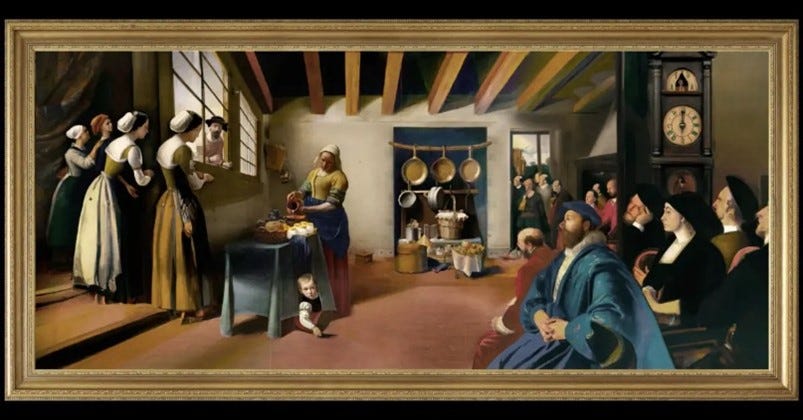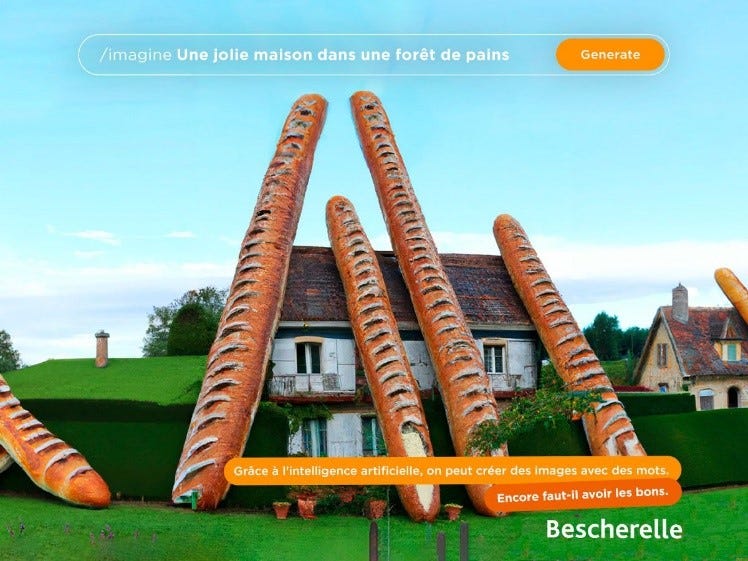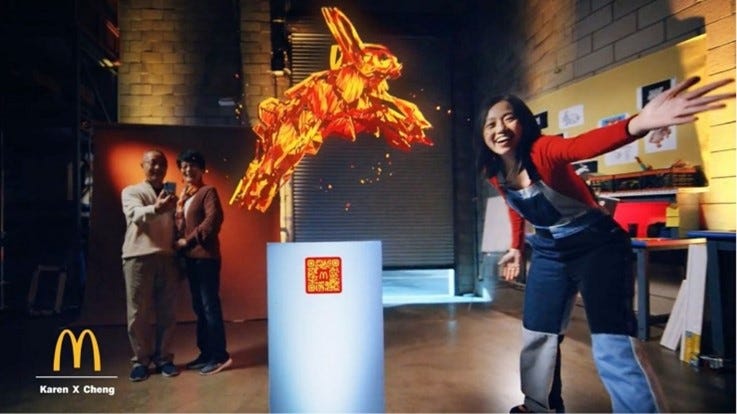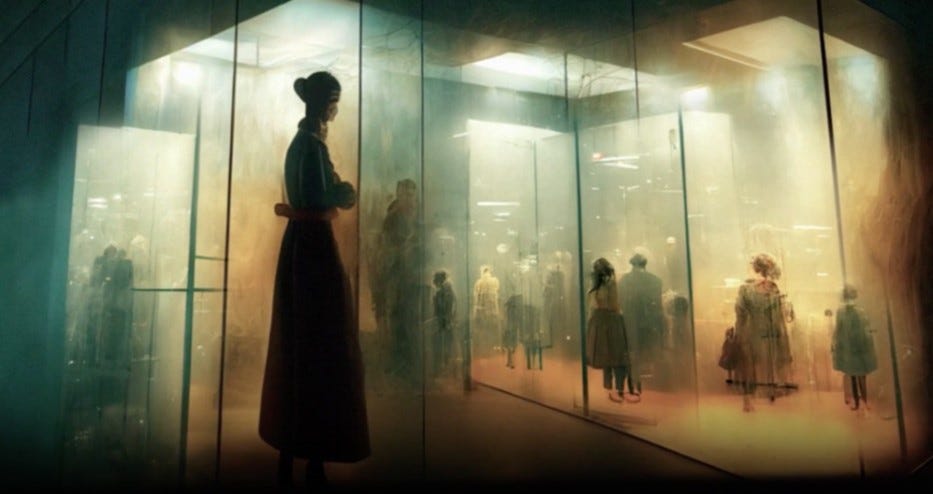If the metaverse already lost word of the year to Gobelin Mode in 2022, this year it is facing a new competition: artificial intelligence. Bill Gates recently pointed that AI was “just as important as laptops and the Internet.” Two months after its debut, ChatGPT has over 30 million users and receives approximately 5 million visits per day. According to New York Times journalist Kevin Roose, this is “the fastest software growth ever observed – Instagram reached 10 million users in one year”.
The not so young among us will remember windows’ famous cartoon helper Clippy. He’d often make unsolicited apparitions when using the Microsoft Office apps and offered to help us, a feat he’d rarely manage to achieve. If we’re bringing him back from the digital graveyard, it is because, before the announced revolution it rumored to be, ChatGPT is nothing more than a Clippy on steroids, on Google’s side as well as Microsoft’s.
THE AUGMENTED HUMAN
Every time AI comes to the mainstream, the end of the human era is proclaimed. However, each time, it is just making it stronger. No need to be a chess player to remember Gary Kasparov being outperformed by DeepBlue, IBM’s supercalculator, and how it spelled game over, humans had been outdone by the machine. Today, the same calculator can’t come close to the current chess world champion Magnus Carlsen. And if he did claim that “engines are stupid” earlier in his career, he has recently admitted that nothing was more powerful than a human “powered by engines.” Currently, AI really is Machine Learning, rather than actual intelligence, and has a long way to go before it can send us back to the concept of Singularity that James Cameron promoted in his cult movie Terminator – I’ll be back.
Though AI is still in its infancy, its impact is already felt. It does not need to be a revolution to have a positive impact on our lives. Indeed, when asked about its reason to exist, ChatGPT answers that it was precisely designed to “improve and enhance the human abilities and skills.”
CNRS researcher Laure Soulier compares it to Wikipedia “When it came out, a lot of people were talking about “the end of school”. And we learned to use these tools. I am confident when it comes to ChatGPT. We will learn to use them, so they can help us to work differently”. It is in fact through this prism that we should tackle the topic of AI: a tool at our disposal, and not instead, of humans.
In the campaigns
- TBWA\Moscow creative director used the AI Midjourney to imagine the ideal collab between IKEA and Patagonia
- Using the AI DALL-E, Ogilvy Paris gives us a glimpse of the other side of the La Laitère painting, for a new definition of Augmented Art.
- In a frame-within-frame campaign, Ryan Reynolds uses ChatGPT to write an ad for his telephone company Mint Mobile
Quick links
- AI's Creative Revolution | Life on the Edge
- Microsoft intègre une technologie de type ChatGPT dans son moteur de recherche Bing - Le Monde
- The Most Important Job Skill of This Century - The Atlantic
AI, LIMITED BY NATURE
Above everything, this technology brings a new form of raw material to feed our imagination. This comes down to the nature of the tools itself, from ChatGPT to DALL-E or even Stable Diffusion. These AI platforms, specialized in text, image or video don’t create anything, but rather generate. Each of them scans the web and its contents, open sourced and copyrighted alike … and then integrate them to their database; their memory, you could say. In response to the more or less original demands - prompts - of its users, the platform remixes existing content into completely relevant or entirely preposterous results. No matter the outcome, it has the advantage of opening the horizon of possibilities. These tools therefore have the potential to inspire and accelerate the production of creative work, but not at any moment does it become a substitute for creativity.
Beyond their promise, the way these tools function is already triggering fundamental ethical questions. Artists are standing up against the absorption of their works to feed these platforms databases. The same tools are of course coded by humans, often sharing the same social and geographical reality, therefore imprinting into it their opinions, biases, and prejudices, with sometimes disastrous outcomes. These questions are essential, and too often perceived as obstacles to innovation by their creators. Talking about AI ethics is a sure way to getting called “scared.” When Rabelais wrote “science without conscience is nothing but the soul’s ruin”, he was terrified. Sometimes, dwelling on a genre that has largely explored these ethical questions can save us some precious time. Fans of hard science-fiction will inevitably think of Isaac Asimov’s Foundations:
I. A robot cannot hurt a human, nor passively let this human be exposed to danger.
II. A robot must obey the orders given by humans, except when such orders are contradictory to the first law.
III. A robot must protect its existence, to the extent that it does not contradict the first or the second law.
Establishing these rules rooted in sensible common sense as soon as possible seems to be the wisest course of action.
In the campaigns
- Bescherelle stays in the zeitgeist with its newest campaign using Midjourney and DALL-E to demonstrate the importance of good spelling especially when it comes to the new skill of writing good prompts when using AI.
- American fast food chain Hardee’s shows what AI can’t do with their campaign #unAImaginable: with more than 100 000 prompt attempts, DALL-E is unable to generate a truthful image of the SUPER STAR burger.
- The AI generated and Seinfeld inspired Twitch show Nothing, Forever was banned from the platform (on which it was broadcasted nonstop) for homophobic and transphobic content.
Quick reads
- Le chef de l'intelligence artificielle de Facebook estime que ChatGPT "n'a rien de révolutionnaire" - BFM TV
- CNET's AI Journalist Appears to Have Committed Extensive Plagiarism - Futurism
- Exclusive: OpenAI Used Kenyan Workers on Less Than $2 Per Hour to Make ChatGPT Less Toxic - Time
AI, ON HEART OUTAGE
When ChatGPT is asked to define itself, its response is quite eye-opening: “I am a linguistic model without personal thoughts or feelings. My goal is to offer precise and useful answers.” This honesty could almost be endearing, if it were not referring us back to the tool’s inherent limits and flaws. In the words of its creators: “ChatGPT’s format should allow it to answer questions in dialogue form, to admit its errors, to contest incorrect information and reject inappropriate answers.”
An ambitious blueprint for a first version to which we easily lend creative intentions, from writing poetry to song lyrics. This brings us to the legendary singer, author, and composer Nick Cave, who reacted to a song “written” in his style by ChatGPT. His sentence is irrevocable: “this song sucks, it is a grotesque imitation of what a human being is.” Indeed, according to him, the creative act is not a matter of imitation, quite the opposite. It is through the confrontation of one’s own vulnerability, faults, and limits, facing what goes beyond us and tears the heart apart, that artists find what was lurking beyond the forefront of their minds. That is precisely why it is a profoundly human process, simply because algorithms don’t feel, because data does not suffer (except in the hands of some planners). ChatGPT’s tragedy is that it is destined to remix without ever being able to create a piece of work deserving to be called authentic.
In the campaigns
- In its last campaign, McDonald’s celebrates the Lunar new year and supports Asian American and Pacific Islander communities. Created in collaboration with the content creator Karen X Cheng, the TV spot uses Nividia's NeRF technology that enables the creation of 3D objects from 2D photos.
- For 2022’s World Mental Health Day, health insurance company Helan used AI to create See My Pain, a campaign destined to make mental illnesses more tangible and easier to talk about.
- To celebrate the Twingo’s 30th birthday, Renault launched a collaborative campaign « Reinvent Twingo », with the goal to invent a show thanks to an AI and participants ideas.
Quick reads
- Could AI Be A Powerful Creative Tool For Brand Marketers? - A.List
- Nick Cave responds to song written by ChatGPT in Nick Cave style - The Red Hand Files
L'intelligence artificielle va-t-elle tuer les artistes ? - France Info Culture
PLANNER POV
The computer, the Internet, the iPhone, all revolutionary technological progress at their time, are today taken for granted. In several instances, Steve Jobs observed that what distinguishes the human species from the other stems from our ability to build tools. He specifically quotes a study comparing our speed compared to those of other animals showing that, unsurprisingly, we were at the bottom of the list. However, it’s another story when the same human is on a bike. This brings him to describe the computer as a “bicycle for the mind.” If a computer can serve as a bike, to what could we compare AI? That is the question we asked ChatGPT. His answer: “a toolbox for the mind.”
In case you wanted to do some digging …
Google chute en Bourse après une erreur de son nouveau robot d'IA - Les Echos
ChatGPT could be a game-changer for marketers, but it won’t replace humans any time soon - The Conversation
Why AI and creativity are not at war - Venture Beat
Getty Images sues AI art generator Stable Diffusion in the US for copyright infringement
OUR PARTING THOUGHTS
It is going to be a while before AI can ever come close to become Rick Rubin’s rival.

I asked ChatGPT to share the three most surprising questions users have asked so far with me :
- “What would happen if the Earth was made of jam ?”
- “What would happen if humans could fly ?”
- “What would happen if all the oceans of the world were replaced by maple syrup ?”
Now it’s your turn !
Initiative’s strategic planning team

